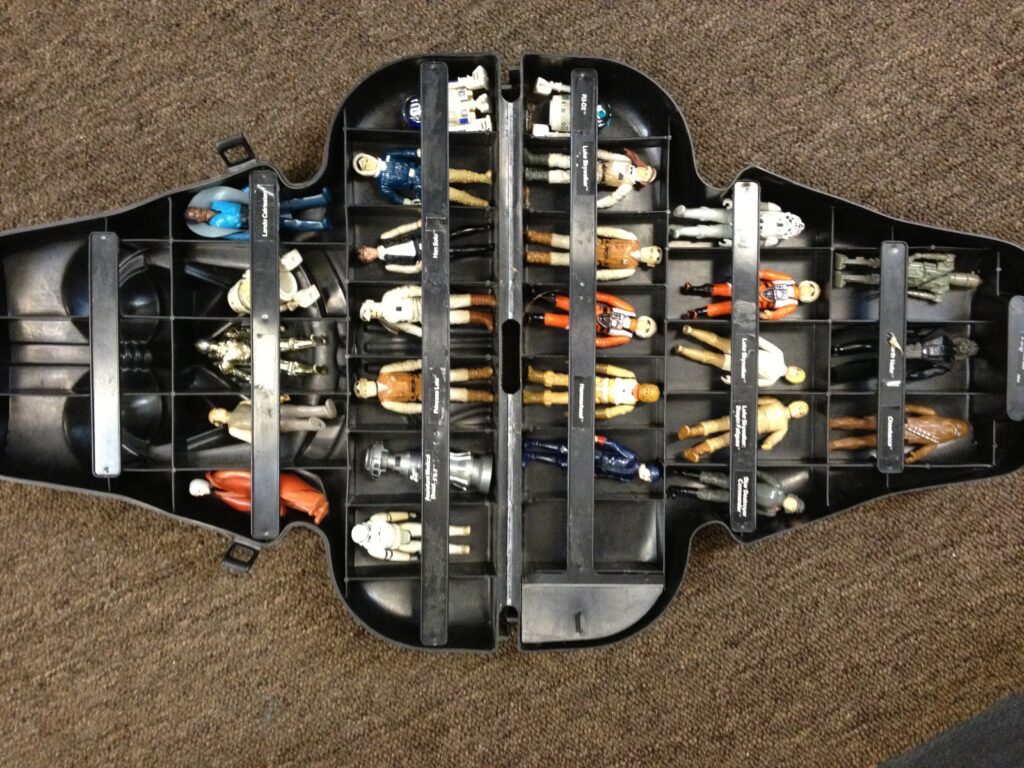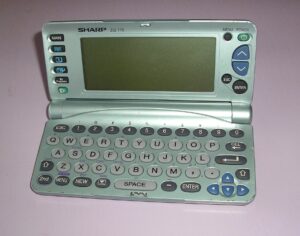So I had to go to storage the other day, to put away the box from my new bass, because if I just threw it in the recycling bin, the truss rod inside the bass neck would have exploded and I would have needed to mail the thing to Germany or Uganda or something for warranty repairs, and I’m pretty sure finding a cardboard box the size of a bass would be a month-long venture. I didn’t want to dig through the unit, although I think I can now shred any files older than 2007, and there are boxes of tax papers going back to 2000 in there, but they’re in the very back of the unit, and that would involve unpacking everything to pull those boxes, so that can be left for some other time.
What I did find though, is something that I thought was lost: a good chunk of my Star Wars action figures from the late 70s/early 80s.
Check this out:
When I was a kid, Star Wars figures and Legos were the father, son, and holy spirit of my life. I probably spent an entire year of my life in the toy aisle of K-Mart, memorizing the back cards of every action figure hanging from the displays, digging through every unit hanging from the metal pegs in hopes that some rare figure would be hidden in the very back. (For example, at one point, the light sabers that extended from the arms of Luke, Obi-Wan, and Darth Vader were two-piece telescoping units; these were later replaced with solid one-piece units that didn’t extend as far. All of my figures came with the later one-piece light sabers, but I was convinced that if I dug around enough, I would miraculously find a two-piece lightsabered figure at the store, which I of course never did.)
Various thoughts about these figures, in no particular order:
- This isn’t my entire collection; I don’t know what happened to all of the rest of them. Notably missing are my original R2-D2, Yoda, and Boba Fett. Also missing are all of the guns and accessories, which are supposed to go in that little compartment with a door.
- I also used to have a set of accessories that you got for mailing in a bunch of proofs of purchase, which included vinyl plastic astronaut-type life support backpacks, gas masks, and a backpack that would hold Yoda on Luke’s back.
- I found this, coincidentally, on the same day I read in David S. Atkinson’s book Bones Buried in the Dirt about a similar Darth Vader case.
- All of the figures I have with capes (Lando, Obi-wan, Vader) all have plastic capes. Some of the first-generation characters had cloth capes, which I believe are much more rare.
- The most predictable comment one would make while looking at this would be “oh man, imagine how much those would be worth in their packages.”
- I had at least two Boba Fett figures. They were also a mail-away, and I had enough points to get more than one. The Boba Fett is best known for having a fixed missile on his back, which was supposed to be a spring-loaded firing missile, but some kid, who may or may not have been Mikey from the Life cereal commercial and/or eating Pop Rocks at the same time, fired the missile down his throat and died. (That’s not what happened.) Almost everyone I know who collected Star Wars figures as a kid claims they had one of the rocket-firing Boba Fetts. They are all liars. They never released one, although in 2010 they finally did. (I guess kids are too obese to choke on rockets now.)
- The original Han Solo figure I have has lost most of his hair-paint. That’s because after Empire, I used to freeze him. Lacking a carbonite chamber, I’d put him in a glass of water and put that in the freezer. This would result in a Han Solo frozen in a round chunk of clear ice, but whatever. This was before the internet, so my entertainment options were limited.
- One of my Hoth Rebel soldiers has a weird looking head. That’s because someone in my school broke the original head off. My dad tapped a set of threads in the head and neck, and sunk a small allen-head bolt in there so the original head screwed back on. This made the figure much cooler, as I could unscrew the head, leaving a bolt sticking out of the neck like a robotic spine.
- My Chewbacca had a weird divot missing from the top of his head, right at the seam. It looks like he was into self-trepannation.
- The R5-D4 figure has only white, worn-off remnants of its original sticker. After this happened, when I got the R2-D2 figure, I painted over the sticker with clear nail polish of my mom’s. This preserved the label, but now it’s got this weird yellowish sheen to it.
- Speaking of discoloration, my Hoth Han Solo appears to have jaundice from a bad case of hepatitis.
- My favorite figures include the Hoth Luke Skywaker, the R2D2 with the extending antenna in his head, and the missing Boba Fett.
- The figures that now seem stupid include Bossk and Lobot (who had a combined total of about 3 seconds of screen time), the Bespin Guard (who looks like a creepy guy with a waxed mustache and beret you’d find hanging out at a leather bar) and the FX-7 robot (which did not have moving legs, could not sit and therefore didn’t fit in any vehicles, and came with no guns or accessories.)
Amazingly, all of these survived. My GI Joes did not – for whatever reason, they were much more susceptible to damage. One of them lost both of his thumbs because he had this bazooka that essentially worked as a large lever to fatigue and break the little plastic digits. So I chopped off his hands, touched up the stumps with red paint, and he became “Can’t Read Text on a Claymore Mine Joe.” When that got boring, I hit him with some aqua-net and a cig lighter, and he briefly became “Victim of a Friendly Fire Napalm Incident Joe” and then “Cannot Identify Remains Joe.”






